Did you know the Catholic Church is the largest non-government provider of education and healthcare worldwide? With over 20,000 schools and 1,500 universities, it serves millions globally, shaping lives and communities.
Founded on the teachings of Jesus Christ, the Church has a rich history dating back to ancient Rome. Its mission extends beyond faith, focusing on education, healthcare, and social welfare. From Europe to the Philippines, its institutions have become pillars of hope and development.
In the Philippines, the Church plays a vital role in education, running schools that nurture both minds and spirits. Its commitment to social welfare is evident in its healthcare services, reaching underserved communities. Understanding its historical evolution helps us appreciate its modern contributions.
Key Takeaways
- The Catholic Church is the largest non-government provider of education and healthcare globally.
- It operates over 20,000 schools and 1,500 universities worldwide.
- Founded on the teachings of Jesus Christ, it has a rich history dating back to ancient Rome.
- In the Philippines, the Church is a key player in education and social welfare.
- Its institutions focus on nurturing both academic and spiritual growth.
Historical Foundations of Catholic Education and Social Service
The roots of Catholic education and social service trace back to ancient traditions. From its earliest days, the Church focused on nurturing both faith and knowledge. This dual mission has shaped communities for centuries.
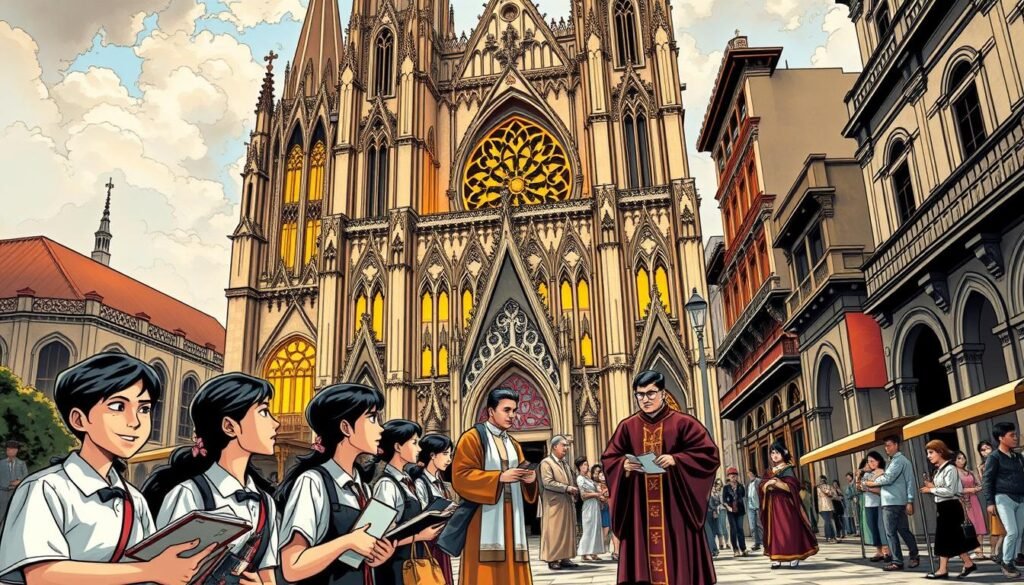
Early Mission and Apostolic Tradition
The Church’s mission began with the teachings of Jesus Christ and the work of His apostles. Leaders like Peter and John played key roles in spreading the faith. They emphasized the importance of caring for others, laying the groundwork for future social services.
Early Christian communities prioritized education and charity. They established schools to teach both religious and secular subjects. This blend of learning and service became a hallmark of the Church’s work.
The Evolution Through the Centuries
Over time, the Church’s role in education and welfare grew. Key events like the Edict of Milan in 313 AD allowed Christians to practice openly. This led to the establishment of more schools and charitable institutions.
The Council of Nicaea in 325 AD further solidified the Church’s structure. It emphasized the importance of education in preserving faith and tradition. These councils helped shape the Church’s approach to social welfare.
The evolution of the papacy also played a significant role. Popes like Gregory the Great supported education and care for the poor. Their leadership ensured that these values remained central to the Church’s mission.
| Key Event | Year | Impact |
|---|---|---|
| Edict of Milan | 313 AD | Allowed open Christian practice, leading to more schools and charities. |
| Council of Nicaea | 325 AD | Strengthened Church structure and emphasized education. |
| Papacy of Gregory the Great | 590-604 AD | Promoted education and care for the poor. |
Today, the Church’s commitment to education and social service continues. Its institutions remain vital to communities worldwide, carrying forward a legacy of faith and care.
The Development of Roman Catholic Practices and Beliefs
The Roman Catholic tradition has evolved over centuries, blending ancient practices with modern beliefs. Its liturgical practices and core doctrines have deep historical roots, shaped by the teachings of Jesus Christ and the work of early church fathers.
One of the key aspects of this evolution is the integration of New Testament teachings with long-held traditions. Early Christian communities emphasized both faith and knowledge, creating a foundation for spiritual and communal growth. This dual focus remains central to the Roman Catholic identity today.
Rituals like baptism and the Eucharist exemplify the spiritual means of the Roman Catholic faith. Baptism, a symbol of rebirth, and the Eucharist, representing the body and blood of Christ, are deeply rooted in New Testament teachings. These practices highlight the connection between faith and daily life.
The role of bishops has been crucial in maintaining the continuity of apostolic succession. Bishops, as spiritual leaders, ensure the preservation of traditions and the spread of the faith. Their leadership has helped shape the doctrinal practices of the Roman Catholic Church.
The development of the “Roman Catholic” identity is marked by its doctrinal statements and emphasis on unity. From the Council of Nicaea to the Second Vatican Council, the Church has continually adapted while staying true to its core beliefs. This balance of tradition and innovation defines its global influence.
- Liturgical practices evolved from ancient traditions to modern rituals.
- New Testament teachings are integrated with long-held traditions.
- Early church fathers played a key role in shaping doctrinal practices.
- Rituals like baptism and the Eucharist highlight spiritual depth.
- Bishops ensure the continuity of apostolic succession.
- The “Roman Catholic” identity is defined by doctrinal unity and adaptability.
Catholic Church and Its Societal Mission in the Philippines
The Philippines, known for its deep spiritual roots, has long been shaped by the influence of faith-based organizations. These groups have played a vital role in education, healthcare, and community development. Their mission is rooted in principles of mercy and charity, which continue to guide their efforts today.
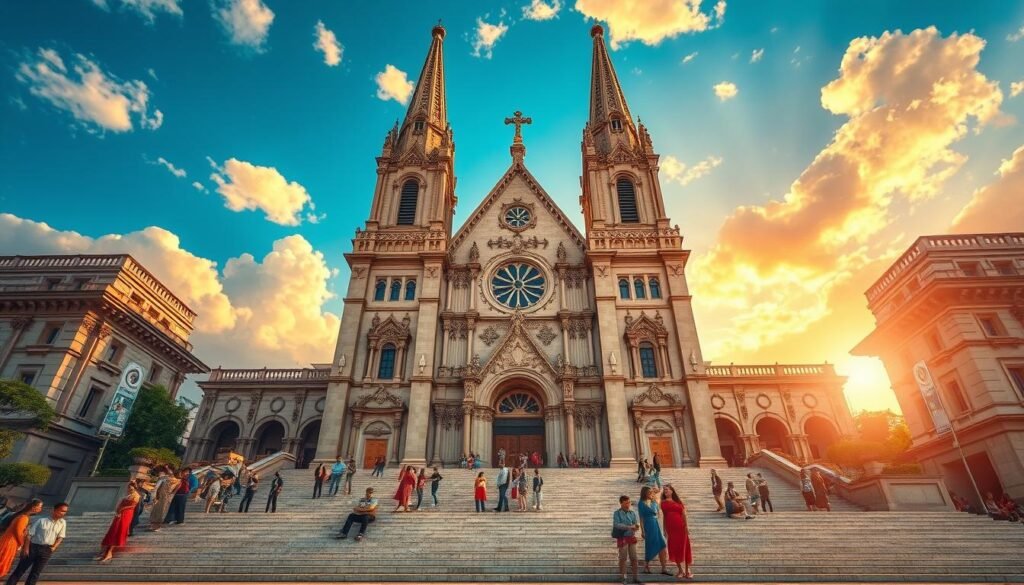
Principles of Mercy and Charity
At the heart of the Church’s work in the Philippines are the principles of mercy and charity. These values inspire initiatives that address poverty, education, and healthcare. Local dioceses often lead these efforts, ensuring that help reaches those who need it most.
For example, many dioceses run feeding programs for malnourished children. They also provide scholarships to underprivileged students. These actions reflect the Church’s commitment to uplifting communities through compassion and service.
Modern Community Outreach Initiatives
In recent years, the Church has embraced modern strategies to expand its outreach. Programs now include disaster relief, environmental advocacy, and digital education. These initiatives aim to address contemporary challenges while staying true to traditional values.
One notable project is the establishment of community health centers in rural areas. These centers offer free medical services, including vaccinations and maternal care. Such efforts demonstrate the Church’s adaptability in meeting societal needs.
| Initiative | Impact |
|---|---|
| Feeding Programs | Provides meals to thousands of malnourished children annually. |
| Scholarships | Supports education for underprivileged students. |
| Health Centers | Offers free medical services in rural areas. |
Faith-based leadership continues to drive these initiatives, ensuring they remain impactful and sustainable. By blending traditional values with modern strategies, the Church remains a cornerstone of societal development in the Philippines.
The Impact of Catholic Education on Philippine Society
Catholic education in the Philippines has been a cornerstone of societal development for centuries. With over 1,300 schools spread across the country, these institutions have shaped minds and communities. They provide not only academic excellence but also moral and spiritual growth.
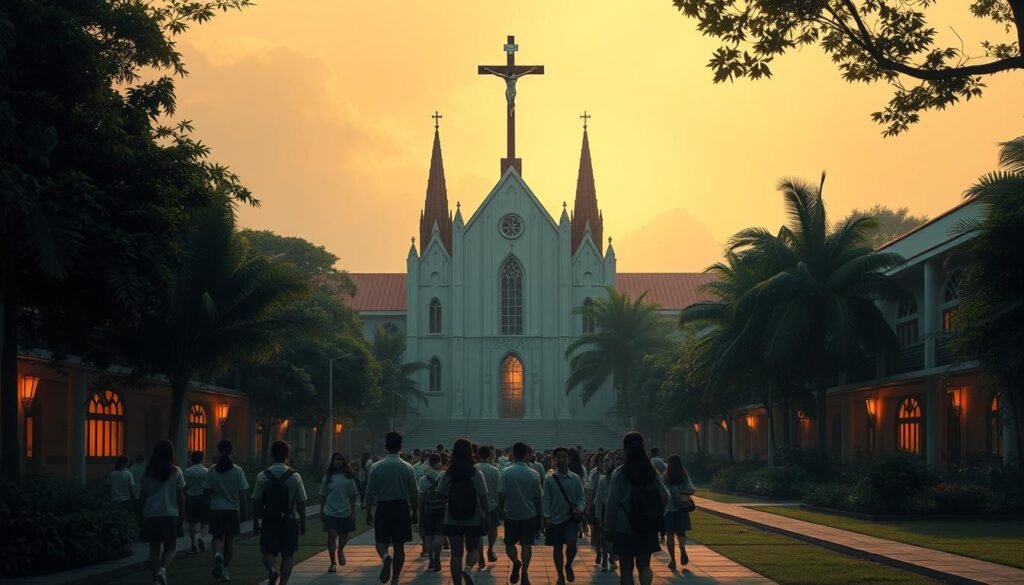
From the first school established in 1565 to the prestigious University of Santo Tomas, these institutions have a rich history. They have played a pivotal role in addressing educational gaps, especially in remote areas. Many schools cater to marginalized communities, offering scholarships and free education.
Catholic Schools and Universities
Catholic schools and universities are known for their holistic approach to education. They integrate moral teachings with academic rigor, fostering well-rounded individuals. The University of Santo Tomas, founded in 1611, is a prime example of this legacy.
These institutions also assist the government in addressing classroom and teacher shortages. They provide an alternative for families seeking quality education rooted in faith. Despite economic challenges, many schools continue to thrive, serving students from diverse backgrounds.
The Role of Religious Education
Religious education is a core component of Catholic schools. It helps students understand their faith while promoting values like compassion and integrity. This focus on character building complements academic learning, preparing students for life beyond the classroom.
Many schools also welcome students of other faiths, fostering interfaith dialogue and mutual respect. This inclusive approach strengthens community bonds and promotes national identity. The Catholic Educational Association of the Philippines (CEAP) supports these efforts, ensuring quality education for all.
| Institution | Year Founded | Impact |
|---|---|---|
| University of Santo Tomas | 1611 | Oldest university in the Philippines, offering diverse programs. |
| Colegio de Sta. Isabel | 1632 | First women’s college, still serving students today. |
| La Salle College | 1925 | Known for its fine school edifice and academic excellence. |
The legacy of Catholic education in the Philippines is undeniable. It has shaped generations, fostering both academic and spiritual growth. Through its commitment to service and excellence, it continues to be a beacon of hope and development.
The Role of the Church in Healthcare and Social Services
The Church’s global healthcare network is a testament to its enduring mission of compassion and service. With over 5,500 hospitals and 18,000 clinics worldwide, it remains one of the largest non-government providers of medical care. These facilities serve millions, especially in developing countries, where access to healthcare is often limited.
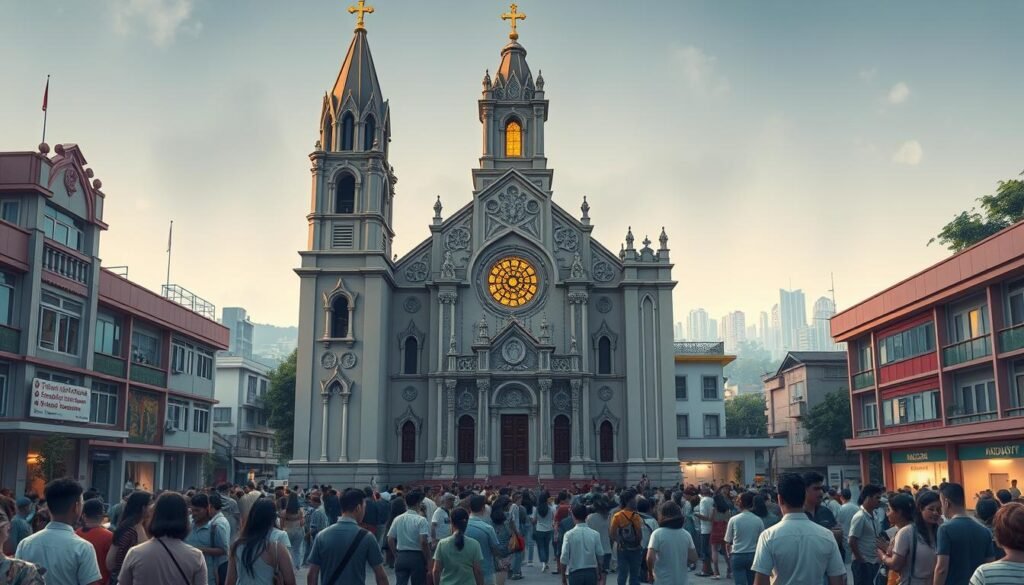
One of the most profound spiritual practices in healthcare is the anointing of the sick. This sacrament offers comfort and healing to those facing illness or death. It reflects the belief in grace and the presence of God during challenging times. This practice underscores the Church’s commitment to holistic care, addressing both physical and spiritual needs.
Faith and healing are deeply intertwined in the Church’s social service programs. Many initiatives combine medical care with pastoral support, ensuring that patients receive comprehensive assistance. For example, hospitals often have chaplains who provide spiritual guidance alongside medical treatment.
Globally, the Church manages approximately 26% of healthcare facilities, with a significant presence in Sub-Saharan Africa and rural areas. In the Philippines, its healthcare services reach underserved communities, offering free clinics and maternal care. These efforts are driven by the principles of compassion and grace, which remain central to its mission.
Leadership from the pope and local dioceses has been instrumental in expanding these services. Initiatives like the Holy See’s WASH program aim to improve healthcare infrastructure and reduce the spread of infectious diseases. Such efforts highlight the Church’s adaptability in addressing modern challenges while staying true to its core values.
Through its healthcare and social services, the Church continues to be a beacon of hope and healing. Its integration of faith and medicine ensures that care is not just about treating illness but also nurturing the soul.
Organizational Structures of the Catholic Church
From the papacy to local dioceses, the Church’s structure ensures unity and effective leadership. This hierarchical model has been refined over centuries, balancing spiritual and administrative responsibilities. At its core, the pope serves as the supreme leader, supported by bishops and cardinals worldwide.
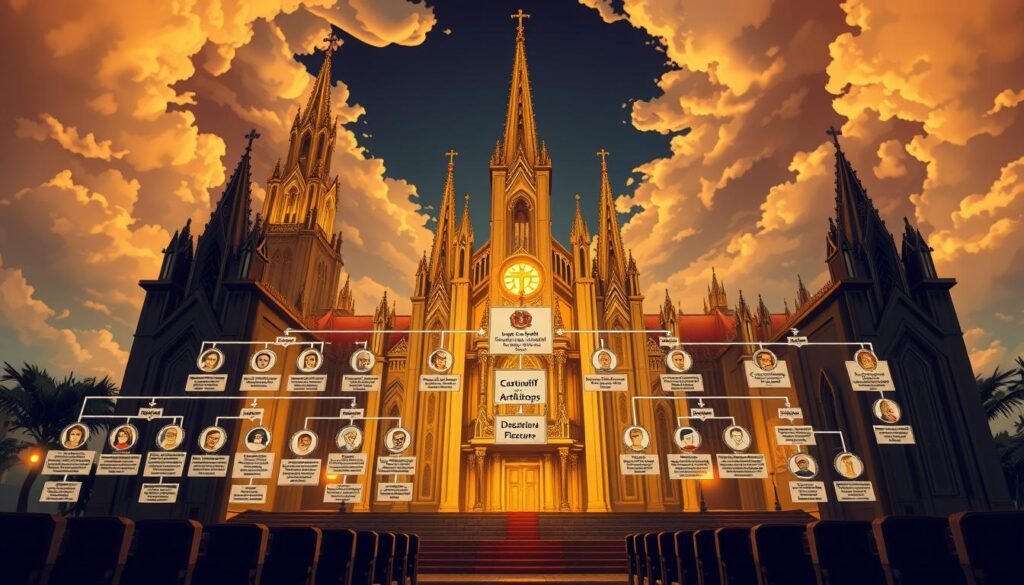
The Papacy and Local Dioceses
The pope, as the bishop of Rome, holds ultimate authority within the Church. He is assisted by the College of Cardinals, who play a crucial role in electing new popes and advising on major decisions. Below the papacy, local dioceses are overseen by bishops, who manage spiritual and administrative duties within their regions.
Dioceses are further divided into parishes, each led by a priest. This structure ensures that leadership is decentralized yet cohesive, allowing the Church to address local needs while maintaining global unity. The Holy See, based in Vatican City, serves as the central administrative body, coordinating activities across dioceses.
Governance and Canon Law
Canon law is the legal framework that governs the Church’s practices and policies. It covers everything from sacraments to administrative procedures, ensuring consistency across its vast network. Bishops and priests are guided by these laws, which are periodically updated to address contemporary challenges.
Ordination and confirmation are key sacraments within this governance model. Ordination grants priests and bishops their spiritual authority, while confirmation strengthens the faith of lay members. These practices highlight the Church’s commitment to both leadership and community.
The Roman Curia, the administrative arm of the Holy See, plays a vital role in implementing canon law and supporting the pope. Its various departments oversee areas like doctrine, liturgy, and social justice, ensuring the Church’s mission is carried out effectively.
Global Influence of the Roman Catholic Tradition
From Rome to the farthest corners of the world, the influence of the Roman Catholic tradition is undeniable. Its reach extends across continents, shaping cultures and communities through centuries of missionary work and migration. This global presence reflects its ability to adapt while maintaining a unified faith.

International Missions and Outreach
Missionary efforts have been a cornerstone of the Roman Catholic tradition. From the early apostles to modern-day missionaries, the church has carried its message of faith and compassion to diverse regions. Today, over 1.3 billion Catholics worldwide are part of this global community.
Cultural diversity is embraced within the church, fostering unity without uniformity. For example, in Africa, vibrant liturgies blend traditional music and dance with Roman Catholic rituals. In Asia, local customs are integrated into worship, creating a unique expression of faith.
The pope plays a pivotal role in this global outreach. Through encyclicals and diplomatic efforts, he addresses issues like poverty, migration, and climate change. The Vatican’s diplomatic presence in over 180 countries underscores its commitment to global peace and justice.
| Region | Number of Dioceses | Key Initiatives |
|---|---|---|
| Africa | 500+ | Healthcare, education, and interfaith dialogue. |
| Asia | 300+ | Support for marginalized communities and disaster relief. |
| Latin America | 700+ | Advocacy for social justice and environmental sustainability. |
Modern outreach programs leverage technology to connect with younger generations. Social media campaigns, online worship services, and digital education initiatives ensure the church remains relevant in a rapidly changing world. This blend of tradition and innovation defines its global influence.
Through its international missions and outreach, the Roman Catholic tradition continues to inspire and uplift millions. Its ability to unite diverse cultures under a shared faith is a testament to its enduring legacy.
Key Historical Figures and Their Contributions
The foundation of the Roman Catholic tradition was shaped by remarkable leaders whose legacies endure today. From the apostles to modern bishops, these figures have influenced governance, education, and social service. Their contributions remain central to the Church’s mission.
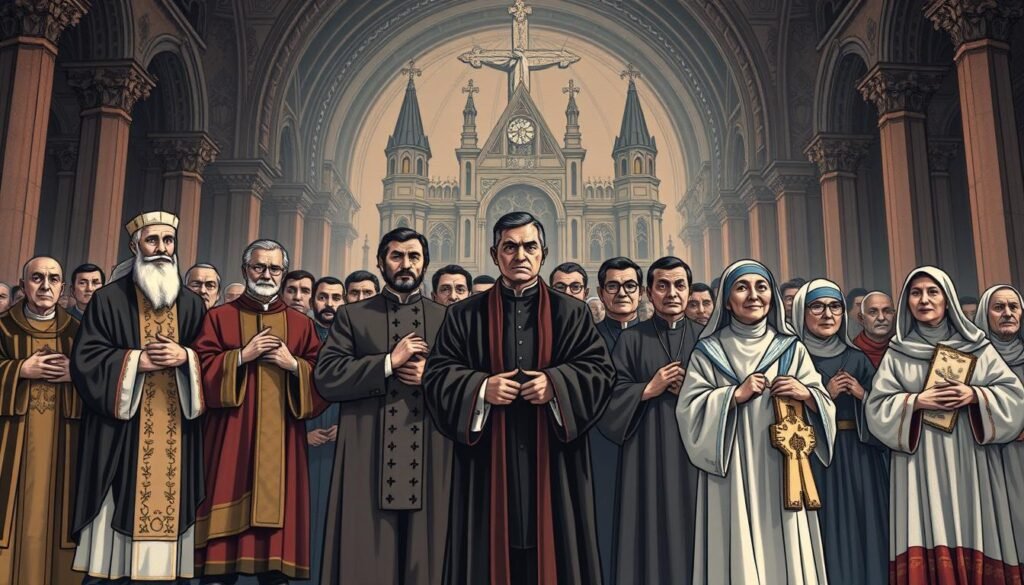
St. Peter, often called the “rock” of the Church, played a pivotal role in its early development. As the first bishop of Rome, he established the papacy, a cornerstone of Church leadership. His teachings and martyrdom set a precedent for faith and sacrifice.
St. John, another key apostle, emphasized love and compassion in his writings. His Gospel and letters continue to inspire Christian communities worldwide. Together, Peter and John laid the groundwork for the Church’s spiritual and administrative foundations.
Other figures like St. Paul expanded the Church’s reach through missionary work. His letters to early communities addressed theological and practical issues, shaping tradition and doctrine. These efforts helped unify diverse believers under a shared faith.
| Figure | Role | Contribution |
|---|---|---|
| St. Peter | First Bishop of Rome | Established the papacy and early Church structure. |
| St. John | Apostle and Evangelist | Authored key texts emphasizing love and faith. |
| St. Paul | Missionary and Theologian | Expanded the Church’s reach through letters and teachings. |
Over centuries, leaders like Gregory the Great and Francis of Assisi continued this legacy. They addressed societal needs through education and charity, ensuring the Church remained a force for good. Their work reflects the enduring impact of early apostles.
Today, the Church’s leadership continues to draw inspiration from these historical figures. Their contributions to governance, education, and social service remain vital to its mission. By honoring their legacy, the Church stays true to its roots while addressing modern challenges.
Understanding Catholic Sacraments and Rituals
Sacraments are central to the spiritual life of believers, offering a pathway to divine grace. These sacred rituals are deeply rooted in the teachings of Jesus Christ and have been practiced for centuries. They serve as a means of connecting with the divine and strengthening communal bonds.

The Eucharist and Other Sacramental Practices
The Eucharist, often called Holy Communion, is the most significant sacrament. It represents the body and blood of Christ, symbolizing spiritual nourishment. Believers partake in this ritual to renew their faith and unite with the community.
Other sacraments include baptism, which marks the initiation into the faith, and confirmation, which strengthens one’s commitment. Ordination grants spiritual authority to priests, while marriage sanctifies the union of two individuals. Each sacrament carries profound spiritual meaning.
Spiritual and Communal Significance
Sacraments are not just personal acts of faith; they also foster communal unity. Through these rituals, believers share in the grace of God and support one another in their spiritual journeys. The sacraments embody the holy traditions passed down through generations.
These practices are rooted in apostolic tradition, ensuring continuity and authenticity. They serve as a reminder of the Church’s mission to guide and uplift its members. By participating in sacraments, believers experience the presence of Christ in their lives.
| Sacrament | Purpose | Key Elements |
|---|---|---|
| Baptism | Initiation into faith | Water, anointing with oil |
| Eucharist | Spiritual nourishment | Bread and wine |
| Confirmation | Strengthening faith | Laying on of hands |
| Ordination | Granting spiritual authority | Blessing by a bishop |
| Marriage | Sanctifying union | Exchange of vows |
| Reconciliation | Forgiveness of sins | Confession, penance |
| Anointing of the Sick | Healing and comfort | Blessing with oil |
Cultural and Artistic Contributions of the Catholic Church
Art and culture have long been intertwined with the spiritual mission of faith-based institutions. From the grandeur of Gothic cathedrals to the intricate details of Renaissance paintings, these creations reflect a deep connection between faith and creativity. This legacy continues to inspire and shape cultural heritage worldwide.
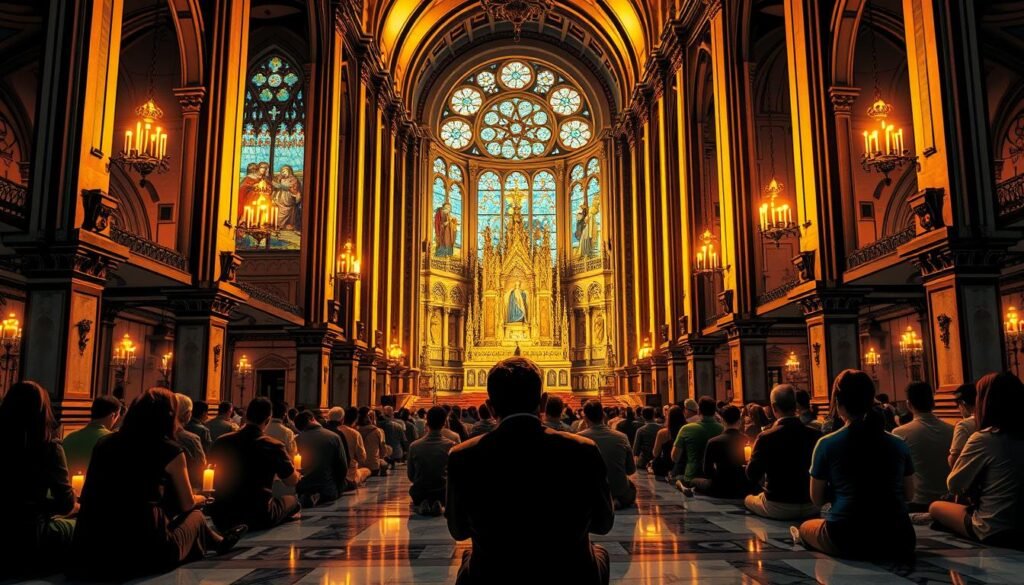
One of the most iconic examples is St. Peter’s Basilica in Rome. Designed by masters like Michelangelo and Bernini, it stands as a testament to the Church’s role in fostering architectural innovation. Its towering dome and intricate sculptures are not just artistic marvels but also symbols of spiritual devotion.
The Sistine Chapel is another masterpiece, showcasing Michelangelo’s breathtaking frescoes. These works, depicting biblical scenes, have become a cornerstone of Western art. They illustrate how religious themes have been a driving force behind artistic expression.
Gothic architecture, with its pointed arches and stained glass windows, also reflects the Church’s influence. Cathedrals like Notre-Dame in Paris and Chartres in France are prime examples. Their design was intended to elevate the soul, creating a space where the divine and the earthly meet.
Beyond architecture, the Church has been a patron of music and literature. Gregorian chants, composed in medieval monasteries, are among the earliest forms of Western music. They were created to enhance worship and have influenced musical traditions for centuries.
In literature, religious texts and themes have inspired countless works. From Dante’s Divine Comedy to modern novels, the interplay of faith and storytelling continues to captivate readers. These works often explore profound questions about life, morality, and the human condition.
| Artistic Contribution | Example | Significance |
|---|---|---|
| Architecture | St. Peter’s Basilica | Symbol of spiritual and artistic grandeur. |
| Painting | Sistine Chapel frescoes | Masterpiece of Renaissance art. |
| Music | Gregorian chants | Foundation of Western liturgical music. |
| Literature | Dante’s Divine Comedy | Exploration of faith and human experience. |
Today, the Church continues to support the arts through initiatives like the Pontifical Commission for the Cultural Patrimony of the. This effort ensures that artistic treasures are preserved and shared, enriching both faith and culture. By blending tradition with innovation, the Church remains a vital force in the world of art and creativity.
Advancing Social Justice and Welfare Policies
Social justice and welfare policies have long been a cornerstone of the Church’s mission to uplift communities. Rooted in its teachings, the Church emphasizes the dignity of every person and the importance of the common good. This commitment is reflected in its efforts to advocate for the poor and marginalized, ensuring that no one is left behind.
Advocacy for the Poor and Marginalized
The Church’s social teaching provides a moral framework for addressing inequality and injustice. Key principles like the preferential option for the poor guide its initiatives, ensuring that resources and support reach those most in need. Programs such as feeding schemes, housing projects, and educational scholarships are designed to empower individuals and families.
Collaboration with government and non-government organizations has been instrumental in expanding these efforts. By working together, the Church and its partners can address systemic issues and create sustainable solutions. This approach reflects the Church’s belief in the power of collective action to bring about positive change.
Case studies from around the world highlight the impact of these initiatives. For example, in the Philippines, community health centers provide free medical services to underserved areas. These centers not only address immediate health needs but also promote long-term well-being through education and preventive care.
| Initiative | Location | Impact |
|---|---|---|
| Feeding Programs | Manila, Philippines | Provides meals to over 10,000 children annually. |
| Housing Projects | Cebu, Philippines | Builds affordable homes for low-income families. |
| Educational Scholarships | Davao, Philippines | Supports over 500 students with access to quality education. |
The Church’s commitment to social justice is also evident in its advocacy for workers’ rights. By promoting fair wages, safe working conditions, and the right to unionize, it seeks to protect the dignity of labor. These efforts are grounded in the belief that work is not just a means of earning a living but also a way to contribute to society.
As the Church continues to address contemporary challenges, its focus remains on integrating faith and practice. By living out its teachings, it inspires individuals and communities to work towards a more just and compassionate world. For more insights, explore the foundations of Catholic social teaching.
Catholic Church’s Role in Educational Reform
Educational reform has become a key focus for faith-based institutions, blending tradition with innovation. These efforts aim to provide holistic education that nurtures both academic and moral growth. By integrating modern technology with time-honored values, they are shaping the future of learning.
Innovative Approaches to Teaching and Learning
Faith-based schools are embracing new technologies to enhance learning experiences. Interactive tools like virtual classrooms and online resources are now part of the curriculum. These methods help students engage more deeply with their studies while staying connected to their faith.
Religious education remains a cornerstone of these institutions. It fosters critical thinking and moral values, preparing students for life beyond the classroom. By combining faith with academic rigor, schools create well-rounded individuals ready to contribute to society.
Reform initiatives include project-based learning and collaborative activities. These approaches encourage creativity and teamwork, essential skills in today’s world. Schools are also focusing on teacher development, ensuring educators are equipped to guide students effectively.
| Initiative | Impact |
|---|---|
| Virtual Classrooms | Enhances accessibility and engagement. |
| Project-Based Learning | Encourages creativity and problem-solving. |
| Teacher Development | Improves instructional quality and student outcomes. |
The influence of traditional values is evident in these modern practices. Faith-based institutions continue to emphasize compassion, integrity, and service. These principles guide their efforts to create inclusive and supportive learning environments.
For more insights into the role of faith in education, explore Catholic social teaching. This resource highlights the importance of collaboration between families, schools, and the state in fostering authentic education.
Contemporary Challenges and Reforms in the Church
Modern society demands that religious organizations adapt to new realities while staying true to their core values. Faith-based institutions are navigating a complex landscape of social criticism, technological advancements, and shifting cultural norms. These challenges have prompted significant reforms aimed at maintaining relevance and addressing pressing issues.
Addressing Social Criticism
One of the most pressing challenges is the growing scrutiny of traditional practices and policies. Critics often highlight issues like transparency, inclusivity, and the handling of abuse scandals. In response, leaders have taken steps to foster accountability and rebuild trust.
For example, the pope has emphasized the importance of listening to the voices of the marginalized. This approach reflects a commitment to addressing systemic issues while upholding the holy mission of the Church. Initiatives like the Synodal Path in Germany demonstrate efforts to create a more inclusive and participatory structure.
Efforts Toward Modernization
Modernization efforts are also reshaping the way faith-based organizations operate. From embracing digital tools to rethinking pastoral care, these reforms aim to meet the needs of a rapidly changing world. For instance, many dioceses now use online platforms to engage younger generations and provide spiritual guidance.
The council of bishops has played a key role in driving these changes. By integrating new technologies with traditional practices, they are ensuring that the Church remains a source of support and inspiration. This balance between innovation and tradition is crucial for long-term relevance.
| Reform Initiative | Impact |
|---|---|
| Digital Engagement | Expands outreach to younger and tech-savvy audiences. |
| Inclusive Leadership | Promotes diversity and representation within the Church. |
| Accountability Measures | Addresses abuse scandals and fosters transparency. |
As faith-based institutions continue to evolve, their ability to adapt will determine their future impact. By addressing contemporary challenges and embracing meaningful reforms, they can remain a vital force for good in society.
The Intersection of Faith, Culture, and Social Responsibility
Faith and culture intertwine to shape societal norms and values. Across the globe, religious teachings influence how communities view marriage, family, and communal responsibility. These principles are not just personal beliefs but are woven into the fabric of daily life.
For example, the teachings of the pope often emphasize the sanctity of marriage and the importance of family unity. These values resonate deeply in cultures where faith plays a central role. In the Philippines, these principles are reflected in community celebrations and public policies that prioritize family welfare.
Cultural expressions of faith are evident in art, music, and public life. From traditional hymns to modern films, these creations reflect the enduring influence of religious values. They serve as a reminder of the connection between faith and cultural identity.
Social initiatives often blend tradition with modern culture. Programs that address poverty, education, and healthcare are rooted in the belief that every person deserves dignity and respect. These efforts highlight the role of faith in promoting social responsibility.
| Initiative | Impact |
|---|---|
| Community Health Centers | Provide free medical services to underserved areas. |
| Educational Scholarships | Support access to quality education for underprivileged students. |
| Feeding Programs | Offer meals to thousands of malnourished children annually. |
Religious principles form an integral part of social responsibility. By addressing contemporary challenges, faith-based organizations continue to inspire and uplift communities. Their work demonstrates the enduring relevance of these values in modern society.
For more insights into how faith shapes social norms, explore this comprehensive analysis.
Looking Ahead: Future Trends in Catholic Education and Welfare
The future of faith-based education and welfare is being reshaped by rapid technological advancements. As the world becomes more connected, faith-driven institutions are finding new ways to serve communities. From digital classrooms to global outreach, these changes are creating opportunities to address modern challenges while staying true to traditional values.
Emerging Opportunities in the Modern Era
Technology is transforming how education and social services are delivered. Virtual classrooms and online resources are making learning more accessible. Faith-based schools are integrating these tools to enhance both academic and spiritual growth. This approach ensures that students are prepared for a rapidly changing world.
Global connectivity is also opening doors for broader outreach. Programs that once served local communities can now have a global impact. For example, digital platforms allow faith-based organizations to share resources and collaborate on initiatives like disaster relief and healthcare. These efforts reflect the grace and compassion at the heart of their mission.
Adapting Traditional Methods for Future Generations
While embracing innovation, faith-based institutions are also preserving their core values. The pope has emphasized the importance of balancing tradition with modernity. This approach ensures that programs remain relevant while staying rooted in holy teachings.
One example is the use of technology to enhance religious education. Interactive tools like apps and virtual reality are helping students engage with their faith in new ways. These methods complement traditional practices, creating a holistic learning experience.
Forecasts and Expert Opinions
Experts predict that faith-based education will continue to evolve. According to recent studies, schools that integrate technology and traditional values are seeing higher enrollment rates. This trend highlights the importance of adaptability in meeting the needs of future generations.
In the Philippines, initiatives like tuition-free schools are making education more accessible. These efforts are supported by the state and local communities, ensuring that no child is left behind. Such programs demonstrate the enduring impact of faith-driven education.
| Initiative | Impact |
|---|---|
| Virtual Classrooms | Enhances accessibility and engagement in education. |
| Global Outreach | Expands the reach of social services and disaster relief. |
| Tuition-Free Schools | Makes education accessible to underprivileged students. |
Visionary leadership will play a crucial role in guiding these changes. The council of bishops and other leaders are working to ensure that faith-based institutions remain a source of hope and inspiration. By embracing innovation and staying true to their mission, they can continue to shape a brighter future for all.
Conclusion
The enduring legacy of faith-based institutions continues to shape education and social welfare globally. Rooted in tradition, these organizations have nurtured both academic and spiritual growth, creating well-rounded individuals ready to contribute to society.
From the leadership of the pope to local initiatives, the commitment to service remains unwavering. Programs addressing poverty, healthcare, and education reflect the core values of compassion and faith. These efforts have transformed communities, especially in regions like the Philippines, where they play a vital part in societal development.
As challenges evolve, so do the strategies to meet them. Embracing technology while staying true to timeless principles ensures these institutions remain relevant. Their mission to uplift and inspire continues to be a beacon of hope for millions worldwide. For more insights, explore this analysis on the role of faith in societal transformation.
FAQ
What is the historical foundation of Catholic education?
The roots of Catholic education trace back to the early mission and apostolic tradition, evolving over centuries to address societal needs through faith-based learning.
How has the Roman Catholic tradition influenced global outreach?
Through international missions and outreach programs, the Roman Catholic tradition has played a significant role in spreading faith, education, and social services worldwide.
What are the key sacraments in the Catholic faith?
The Eucharist, baptism, confirmation, and other sacraments hold deep spiritual and communal significance, fostering a connection between individuals and their faith.
How does the Catholic Church contribute to social justice?
The Church advocates for the poor and marginalized, promoting policies and initiatives that advance social welfare and equality.
What role does the Church play in healthcare and social services?
The Church operates numerous healthcare facilities and social service programs, providing care and support to communities in need.
How has Catholic education impacted Philippine society?
Catholic schools and universities in the Philippines have shaped generations by offering quality education rooted in moral and spiritual values.
What are the organizational structures of the Catholic Church?
The Church is governed by the papacy and local dioceses, with canon law providing the framework for its administration and practices.
Who are some key historical figures in the Catholic Church?
Figures like St. Peter, St. Augustine, and St. Teresa of Calcutta have made lasting contributions to the Church’s mission and teachings.
What are the contemporary challenges facing the Church?
The Church addresses social criticism and modernization efforts while striving to uphold its core values and traditions.
How does the Church integrate faith, culture, and social responsibility?
The Church fosters a balance between faith, cultural heritage, and social responsibility, encouraging communities to live out their beliefs in meaningful ways.
What future trends are emerging in Catholic education and welfare?
The Church is exploring innovative approaches to education and welfare, adapting to modern challenges while staying true to its mission.
Source Links
- Social Welfare and Catholic Social Teaching: Foundational Theological Principles for Case Studies
- Gravissimum educationis
- Catholic Social Teaching | Catholic Community Services of Western Washington
- Why Catholic Education? | Diocese of Sacramento
- Trace the History of the Roman Catholic Church
- What is the origin of the Roman Catholic Church?
- Catholic Church in the Philippines
- No title found
- The Catholic Church in the Philippine Public Sphere
- 400 Years of Catholic Education in the Philippines
- Catholic Church and health care
- The Role of the Catholic Church in Healthcare Provision Globally | ICN
- Hierarchy of the Catholic Church
- The organization of the Roman Catholic church
- United States Catholic Church Structure – Welcome to Catholic Life – Catholic Online
- The Catholic Church and American Foreign Policy
- Millennial input, 5 examples Catholic greatness
- Globalization and the church
- Roman Catholicism | Definition, Religion, Beliefs, History, & Facts | Britannica
- History of the Catholic Church
- The Seven Sacraments of the Roman Catholic Church | Britannica
- Christianity: Roman Catholic – Rituals and Practices
- Catholic art
- What Happened to the Catholic Church’s Art Patronage
- Compendium of the Social Doctrine of the Church
- Principles of Catholic Social Teaching – Seton Hall University
- Principles for Education Reform
- Catholic Education and the Idea of Curriculum
- Statement on Education Reform | Michigan Catholic Conference
- Roman Catholicism – Ecumenism, Liturgy, Doctrine | Britannica
- World Synod: Catholic Church identifies areas for reform
- Library : Francis As the Model of Authentic Church Reform
- No title found
- Panel Discussion: The Intersection of Faith, Culture, Work, Economics – Christ and Culture
- Responsibility, Rehabilitation, and Restoration: A Catholic Perspective on Crime and Criminal Justice
- Catholic schools look ahead with innovation but also focus on tradition
- Looking Forward to 2023 | Alliance for Catholic Education
- Logical Conclusion
- Library : Compendium of the Social Doctrine of the Church: Conclusion

